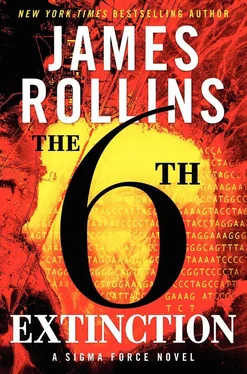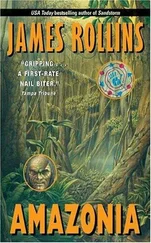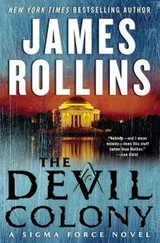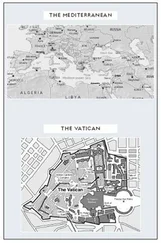Cutter scoffed. “By attempting to engineer XNA hardiness and adaptability into various species as a whole? All you’re doing is stealing from one biosphere in order to preserve another that is dying.”
Kendall’s back stiffened. So Cutter knew what he had been attempting to accomplish. The scientific term for it was facilitated adaptation, to fortify DNA in order to make a species more resistant to disease or make it more robust to survive in a harsh environment. He refused to apologize for his work. His research had the potential to protect many species against the ravages to come, but his work was still in its early stages. Unfortunately, what he had created so far was unrefined, dangerous, consuming all it touched, destroying any DNA it encountered.
It was never meant to be released.
As anger flared anew, Kendall confronted Cutter. “Then what would you have us do? Nothing?”
Cutter turned to him. “Why not? Get out of nature’s way. Nature is the greatest innovator of all. It will survive us… maybe not in the form that you like or are familiar with. In the end, evolution will fill all those gaps created by a major die-off. All five past extinctions triggered an explosion of evolution afterward. Look at humankind. The dinosaurs had to die so we could rise. It is only through death that new life can grow.”
Kendall had heard this central tenet of Dark Eden often enough to recognize it here. He boiled it down to its essential. “The great extinction holds the promise to bring about a new genesis.”
Cutter nodded. “The beginning of a new Eden.”
From the ardor in the other’s voice, it sounded like he could not wait for that to happen.
Kendall sighed. “There remains a fundamental flaw to your reasoning.”
“And what is that?”
“Extinction is fast. Evolution is slow.”
“Exactly.” Cutter stopped, looking close to hugging him for a moment. “That’s exactly right! Extinction will always outpace evolution. But what if we could speed evolution up?”
“How?”
“I’ll show you.”
Cutter had reached a thick steel door that blocked the tunnel. He pulled a keycard from around his neck. “Conservation must worry less about preserving the life that was, and focus on nurturing what will come next.”
“But how do we know what’s coming?”
“We create it. We direct evolution toward this new genesis.”
Kendall was stunned into silence.
Cutter swiped his card, and thick bolts began to slowly unlock.
“That’s impossible,” Kendall whispered, but even he couldn’t convince himself. Genetic engineering and DNA synthesis were already at that threshold.
“Nothing’s impossible,” Cutter countered, as he pulled open the door. “Not any longer.”
Bright daylight flooded the dimly lit tunnel, accompanied by a sweet mélange of scents undercut with the familiar muskiness of loam and rotted leaf. Drawn by that light, by the fresh air, Kendall followed Cutter gladly out of the passageway and onto a metal scaffolding that protruded from the side of a cliff.
As his boots clanked across the grating, Kendall craned up at the blue sky. The perch was fifteen feet from the lip of what appeared to be a huge sinkhole. The walls had been terraced into various levels of gardens, bursting with orchids, bromeliads, leafy vines, and blossoms of every hue and size. Each tier was connected by a winding road that corkscrewed along the inside walls.
Kendall watched an electric golf cart glide silently along that road, climbing toward their position, passing by gates that opened automatically before it. A triangular yellow sign with a black lightning bolt hung on the neighboring fence, indicating that each level’s barrier was electrified.
Worry dampened his momentary wonder.
Cutter stood to the side, scanning the nearby walls, as if searching for weeds growing in his fantastical garden. “Ah,” he finally said. “Down here. Come see for yourself.”
He opened a gate along the landing’s railing and climbed down a steep set of metal stairs to the stone road winding by at his level. Kendall kept his gaze away from that long central drop. It was so far down that he could barely see the bottom, especially with the morning sun still low on the horizon. Still, he noted what appeared to be the crowns of giant trees down there, possibly a piece of the Brazilian rain forest trapped below.
With great care, Kendall stepped from the steel stairs to ancient sandstone. He retreated from the edge of the road, away from that yawning precipice. On the far side spread a series of raised beds, about ten yards deep. They rode up against the cliffs, merging with the thick cascade of green growth that draped the walls. Narrow walkways crisscrossed those plantings. It all could be easily mistaken for some organic vegetable garden, but Kendall suspected what grew here was something far more insidious and anything but organic.
He noted a string of long-legged ants, each the size of his thumb, parading along the edge of one box.
“ Paraponera clavata ,” Cutter named them. “Commonly known as bullet ants. Those little buggers got their nickname because their bite is considered one of the worst stings. The very top of the Schmidt sting pain index. Victims compare it to getting shot, and the pain can last for up to twenty-four hours.”
Kendall took a step back.
“I was able to double their venom load.”
Kendall glanced harshly at Cutter.
“A bite from one of these will leave you paralyzed and in excruciating pain. One of my workers accidentally got stung. He broke his back molars from the grinding pain. But that’s not all. Come a little closer.”
No thank you .
Kendall stayed rooted in place.
Cutter picked up a broken piece of a branch. “Bullet ants — like all ants — are ground-locked members of the Hymenoptera order, which includes bees and wasps.”
He poked a reddish-black straggler, which responded by flaring out small membranous wings, all but invisible before. It flew a few inches away, then landed amid its stinging brethren, stirring them up.
“It was easy to return their wings to them,” Cutter said. “Just a matter of splicing in genes from a tarantula hawk wasp. Especially as the two species share the same genetic heritage.”
“You created a chimera ,” Kendall finally choked out. “A genetic hybrid.”
“Precisely. I haven’t been able to give them full flight yet, so far just those little buzzing bursts like you saw, but hopefully with time and environmental pressure, nature will do the rest, getting them flying as readily as their waspish cousins.”
“How?” Kendall sputtered for a moment. “How did you accomplish this?”
“It was not all that difficult. You know as well as I that the technology is currently available. It was just a matter of having the will and resources to do it, free of oversight and regulation. You already saw my lab is equipped with multiple stations that use the latest CRISPR-Cas9 technique. A process I’ve refined further, by the way.”
That was chilling news. CRISPR-Cas9 could already engineer any part of a genome with such precision that it had been likened to editing individual letters in an encyclopedia without creating a single spelling error.
“And you’re certainly familiar with the MAGE and CAGE processes developed by George Church.”
Kendall felt the blood drain into his legs. Like CRISPR, those two new techniques — multiplex automated genome engineering and conjugative assembly genome engineering — were sometimes referred to as evolution machines. These two gene-editing technologies were indeed just that, capable of automating thousands of genetic changes at the same time. They could introduce millions of years of evolution within minutes.
Читать дальше










